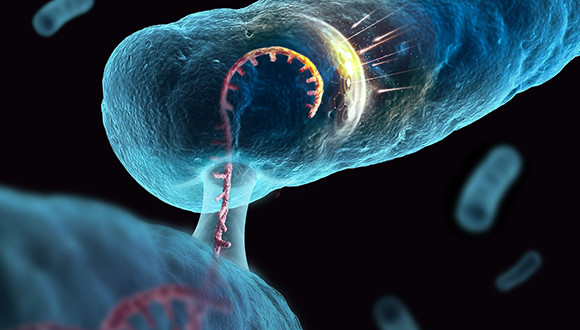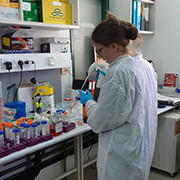Beating the Bacterial Iron Dome
New research discovers how foreign DNA overcomes the bacterial defense systems. The discovery could be used to battle antibiotic resistance and for the manipulation of bacteria for health, industrial, and environmental purposes
Genetic variability is crucial for the survival of species and the ability to respond to changing environments. Sexual reproduction offers us and many other organisms an efficient means to mix genes and create such variability. For bacteria and other microorganisms, this type of reproduction is impossible. Yet, as can be painfully evident in the spread of antibiotic resistance in bacterial populations, they have other effective ways for sustaining such variability - by directly transferring DNA from one bacterium to another.
This mechanism of DNA exchange is key for the survival of bacteria, but a crucial part of this process has largely been ignored by most researchers thus far: how does this exchange happen so frequently despite multiple defense systems designed specifically to destroy any foreign, even beneficial, genetic material entering bacterial cells? In new research published in Nature Journal, scientists from Dr. David (Dudu) Burstein's lab at Tel Aviv University's Shmunis School for Biomedicine and Cancer Research reveal how these defense mechanisms are overcome, facilitating this effective exchange of genetic material between bacteria. This new understanding could potentially help address the antibiotic resistance crisis and pave the way for developing more effective strategies to manipulate bacterial populations for therapeutic, industrial, and environmental applications.
Direct Bacterial Connections
The study focuses on conjugation, one of the main means bacteria use to exchange DNA. Conjugation occurs when a bacterial cell directly connects to another via tiny tubes, transferring pieces of genetic material called ‘plasmids’. "Plasmids are small, circular, double-stranded molecules of DNA which we refer to as 'mobile genetic elements'. Like viruses, they can transfer from one cell to the other, yet, unlike viruses, they don’t kill their host when transferring between different bacteria" explains Dr. Burstein.
As part of the “give and take” of nature, plasmids often give their receiving and hosting bacteria genetic advantages. Many antibiotic-resistance genes, for example, are spread via plasmids. On the other hand, bacteria have multiple defense systems designed specifically to destroy any foreign genetic material entering their cells. "Conjugation is a well-known mechanism widely used by scientists to clone, transfer, and manipulate bacterial genes. It is also known that bacteria have defense mechanisms against foreign DNA, including DNA from plasmids - some of these defense mechanisms are even used in the lab. But until today, no one tried to fully understand what allows plasmids to overcome these mechanisms," adds Dr. Burstein.
The new research was led by Bruria Samuel, a PhD student in Burstein's lab. "I started this research by computationally analyzing genetic data of over 33,000 plasmids and identified genes known to be involved in overcoming bacterial defense systems," describes Samuel. What is even more interesting is where these genes were located. Plasmids are circular and double-stranded. In order to move through a tiny tube connecting the bacteria, one of the strands of the circular DNA is nicked at a certain site (called "nic") and a specific protein then binds the loose strand of DNA and initiates its transfer through the tube to the recipient cell. "The anti-defense systems I found were highly concentrated next to this cutting point and were oriented such that they are the first genes to enter the new cell during the transfer process. This strategic positioning allows these genes to be activated very quickly, giving the plasmid a crucial advantage in overcoming the receiving bacteria's defense mechanisms".
Location, Location, Location
Dr. Burstein says that when Samuel showed him the results, they looked so logical he was convinced someone had already reported this phenomenon in the past. "Bruria performed an in-depth literature search, which showed no one has ever made this connection." This discovery was computational only, using bioinformatic analysis of existing datasets. Naturally, the next step was to demonstrate this experimentally in bacteria that transfer plasmids. "To do so, we used plasmids that can confer bacteria with antibiotic resistance. We transferred the plasmids into bacteria equipped with the famous bacterial defense system CRISPR-Cas9 (which has also become a highly powerful and popular genome editing tool)," explains Samuel. "The CRISPR-Cas9 system can also target plasmid DNA. This way we could add antibiotics to the culture and easily check whether our plasmid manages to overcome the defense system – and the bacteria becomes resistant to antibiotics. If not - they die."
Using this method, Samuel was able to clearly demonstrate that when the anti-defense genes were located in the right orientation within the region that enters the bacteria first, the plasmid was able to overcome the CRISPR-Cas9 system in the bacteria. Yet, when the anti-defense genes were located in other areas or orientations in the plasmid, the CRISPR-Cas9 system demolished the plasmid containing the antibiotic resistance, and the bacteria died when exposed to antibiotics. In addition to Samuel, other researchers in Burstein’s lab also contributed to the study, including Dr. Karin Mittelman, Shirly Croitoru, and Maya Ben Haim.
Dr. Burstein adds that understanding the positioning of the anti-defense genes on the plasmid can lead to the discovery of many unknown genes and anti-defense systems - a highly studied and impactful field of research these days. "In addition, our study can help design more efficient plasmids for genetic manipulation of bacteria for industrial processes. Plasmids are already a common tool for such purposes, but their efficacy of transferring genetic material in industrial settings is much lower than in nature," says Dr. Burstein. "Another possibility is to design effective plasmids for genetic manipulation of natural bacterial populations, whether it is to neutralize antibiotic resistance genes in bacteria in hospitals, 'teach' bacteria in soil and water to remove pollutants or fixate carbon, or manipulate bacteria in our gut to improve our health."





